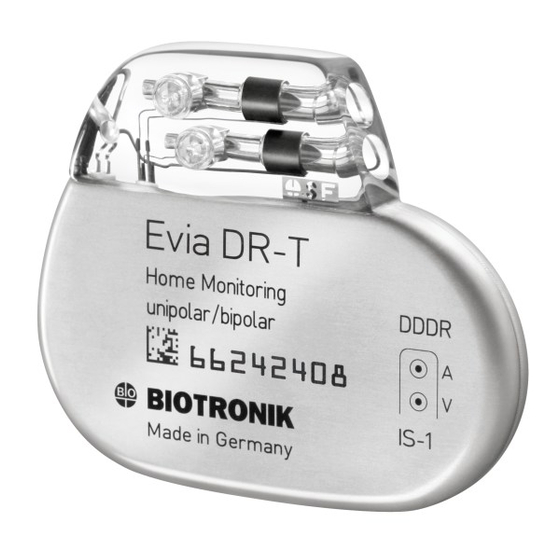
Table of Contents
Advertisement
Advertisement
Table of Contents

Summarization of Contents
Warnings and Precautions
Medical Therapy
Precautions for using therapeutic diathermy equipment with pacemakers.
Magnetic Resonance Imaging (MRI)
Avoid MRI due to potential movement, pain, injury, or damage to the device.
Transcutaneous Electrical Nerve Stimulation (TENS)
TENS may interfere with pulse generator function; measures to reduce interference.
Defibrillation
Precautions to minimize risks of defibrillation affecting pulse generator operation.
Radiation
Pulse generator electronics may be damaged by radiotherapy; use shielding.
Lithotripsy
Lithotripsy treatment should be avoided due to possible interference with the pulse generator.
Electrocautery
Avoid electrocautery near the device; use asynchronous pacing to prevent inhibition.
Storage and Sterilization
Guidelines for storage temperature, handling, single-use, packaging, and magnets.
Lead Connection and Evaluation
Requirements for lead connection and evaluation, including IS-1 compatibility.
Adverse Events
Observed Adverse Events
Summary of adverse events reported in clinical studies for earlier generations.
Potential Adverse Events
List of possible adverse events that may occur with this type of device.
Clinical Study
Dromos DR
Evaluation of safety and effectiveness of the Dromos DR pulse generator.
Ventricular Capture Control (VCC)
Clinical study on the safety and effectiveness of the Ventricular Capture Control feature.
Closed Loop Stimulation (CLS)
Clinical studies supporting the safety and effectiveness of CLS.
TRUST Clinical Study
Study demonstrating safety of BIOTRONIK Home Monitoring system.
Programmable Parameters
Pacing Modes
Overview of available pacing modes including rate-adaptive and CLS modes.
Rate Related Functions
Parameters related to basic rate, hysteresis, night mode, and rate fading.
Pulse Specific Features
Parameters for pulse amplitude and pulse width.
Automatic Sensitivity Control (ASC)
Feature for automatically measuring and adapting sensing thresholds.
Timing Features
Parameters related to refractory periods, PVARP, AV delay, and blanking periods.
Lead Polarity
Determines sensing or pacing configuration (unipolar/bipolar).
Parameters for Rate-Adaptive Pacing
Functions for tailoring motion-based rate adaptation and CLS.
Management of Specific Scenarios
Features for handling specific situations like 2:1 Lock-In and PMT.
Atrial Upper Rate
Prevents atrial pacing in vulnerable phase and ensures correct atrial refractory period.
Atrial Overdrive Pacing (Overdrive Mode)
Increases atrial pacing rate to suppress atrial tachyarrhythmias.
Statistics
Statistics Overview
Overview of stored statistical information like histograms, counters, trends.
Timing Statistics
Event counters, episodes, and rate trends over 24 hours and 240 days.
Arrhythmia Statistics
Atrial burden, time of occurrence, and mode switching statistics.
Sensor Statistics
Sensor histogram and activity reports for evaluating sensor performance.
Pacing Statistics
Lead impedance trends, pulse amplitude, and capture control status.
Sensing Statistics
P/R-wave trends, far-field histogram, and interval distribution curves.
IEGM Snapshots
Stored intracardiac events triggered by specific events for later review.
Other Functions/Features
Safe Program Settings
Quick and convenient way to provide VVI pacing in urgent situations.
Magnet Effect
Describes asynchronous and synchronous magnet effects on pacing.
Temporary Programming
Activating a temporary pacing program for evaluation or testing.
Patient Data Memory
Storage of individual patient data within the pulse generator's memory.
Pacing When Exposed to Interference
How the device responds to EMI and potential interference.
Product Storage and Handling
Sterilization and Storage
Guidelines for storage temperature, handling, and packaging integrity.
Opening the Sterile Container
Procedure for opening the sterile container using aseptic technique.
Pulse Generator Orientation
Information on using the pulse generator in either left or right pectoral implants.
Lead Connection
Auto Initialization
Detects lead connection, polarity, and configures initial features automatically.
Follow-up Procedures
General Considerations
Verifies function, optimizes settings, and corrects malfunctions via reprogramming.
Real-time IEGM Transmission
Real-time transmission of intracardiac electrograms to the programmer for display.
Threshold Test
High-precision test to determine pacing threshold and adjust pulse amplitude.
Non-Invasive Programmed Stimulation (NIPS)
Externally controlled pacing pulses for diagnostic or therapeutic purposes.
Optimizing Rate Adaptation
Checking and adjusting rate adaptation parameters for individual suitability.
Explantation
Common Reasons to Explant a Pulse Generator
Lists common reasons for device explantation, including patient death, infection, or upgrades.
Technical Data
Modes
Table listing available pacing modes for different Evia models.
Pulse- and Control Parameters
Details ranges and settings for basic rate, hysteresis, AV delay, etc.
Rate Adaptation
Parameters for sensor gain, threshold, maximum rate, and rate decrease.
Ventricular Capture Control (VCC)
Settings and parameters for the Ventricular Capture Control feature.
Home Monitoring Parameters
Settings for the Home Monitoring system, including transmission intervals.
Additional Functions
Comprehensive list of other available functions dependent on configuration.
NIPS Specifications
Specifications for Burst Stimulation, Programmed Stimulation, and Back-up Pacing.
Mechanical Data
Physical dimensions, mass, and volume for Evia models.
Appendix A
Mode-Specific Indications and Contraindications
Indications and contraindications for various pacing modes.
Appendix B
Known Software Anomalies
Lists known software anomalies and their possible effects on patients or procedures.

Need help?
Do you have a question about the Evia SR and is the answer not in the manual?
Questions and answers